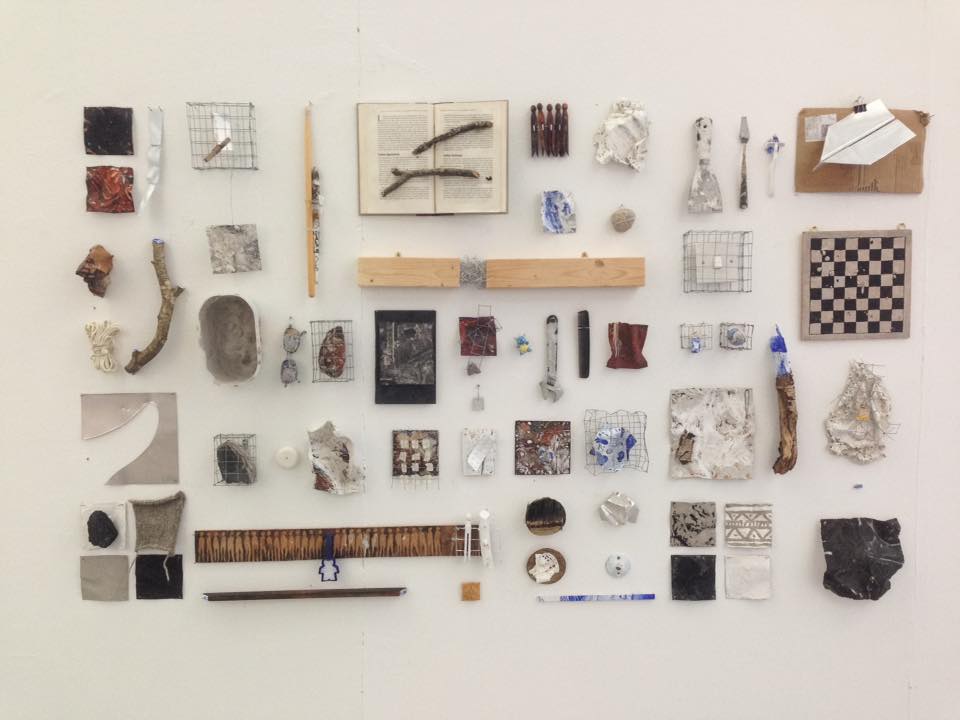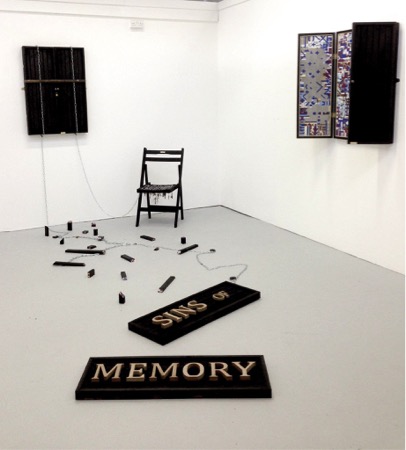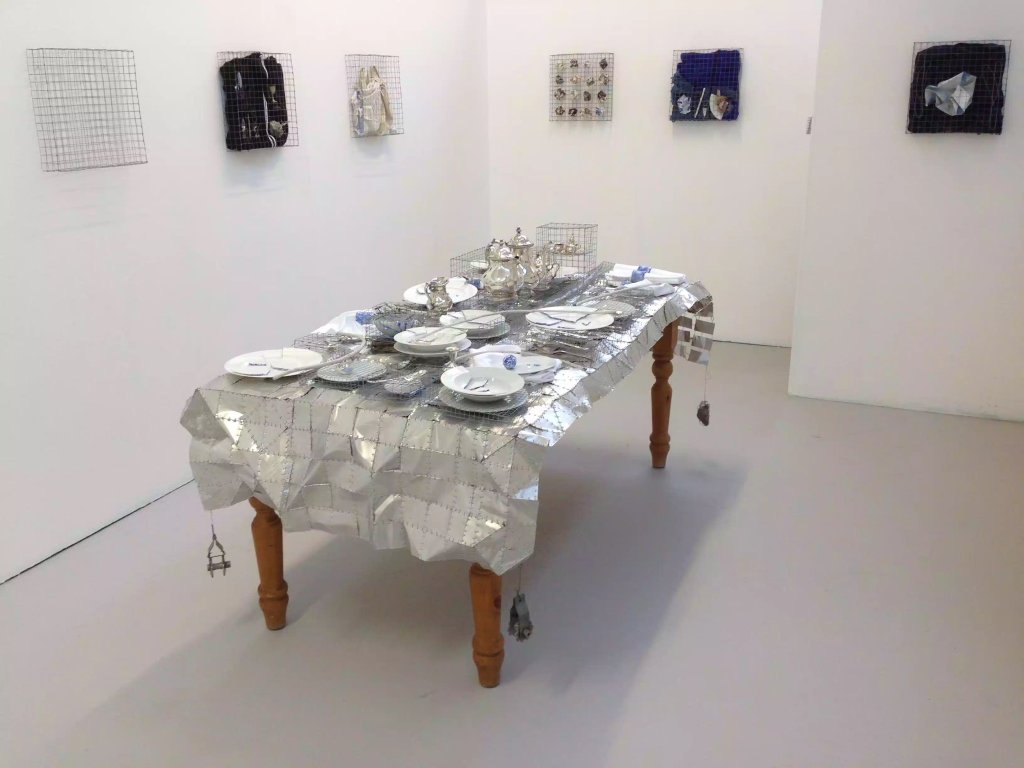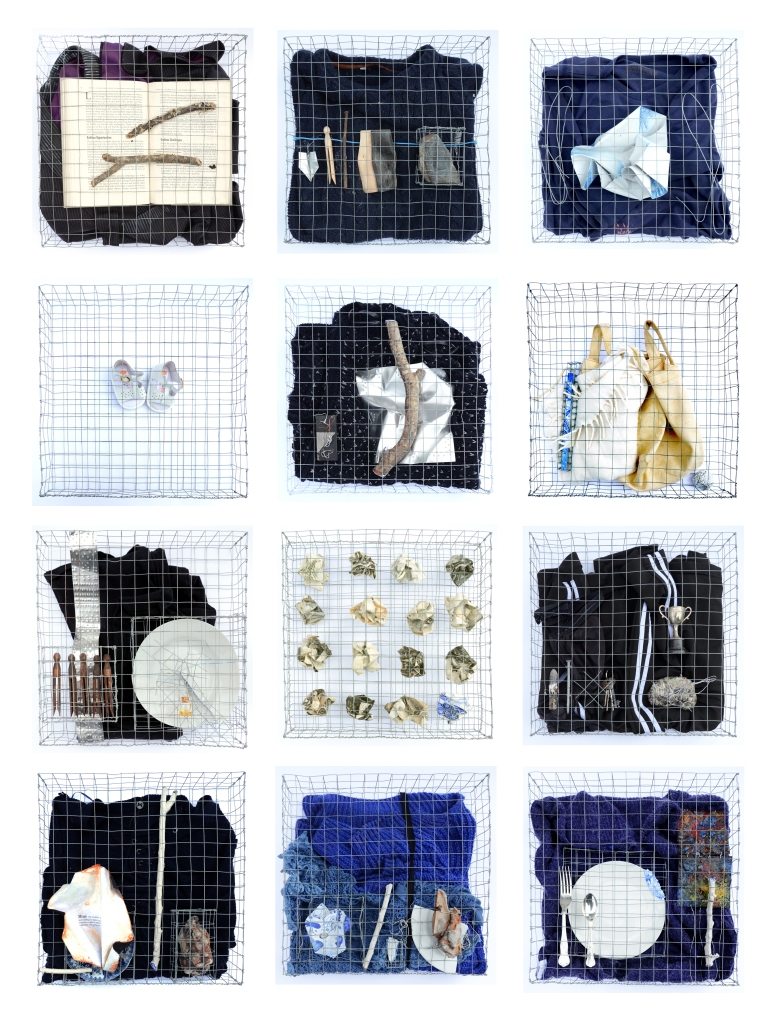Memory has been a long-term theme of the artist’s work and continues to inform his current practice. The work here is part of a master’s programme in contextualised practice undertaken at Grays School of Art. The work explores a wide variety of aspects of memory, looking at numerous theories and its history within the field of cognitive psychology.

Corrupted Memories: arbitrary connections and strategic displacements
This piece explores concepts surrounding memory storage and retrieval. It uses digital data storage and its possible corruption as an analogy of the work by Atkinson and Shiffrin (1968) in which they describe a multi-store model of memory. This model has also been likened to a library where all the books have been stored and indexed. So long as they are correctly catalogued and placed back in the right place the information can be retrieved.In 1980, Loftus and Loftus stated that:
“Everything we learn is permanently stored in the mind, although sometimes particular details are not accessible (p. 410) “
The multi store model is widely viewed as an overly simplified theory of memory storage.One of the arguments against this model is in the multiply way that memories are indexed and that triggers are not always obvious or predictable. For example an object such as a glove could be stored in multiple areas based on its material, colour, pattern, owner, where it was worn, the events taking place at the time, the list goes on. This suggests a memory storage and retrieval system that is less rigid, based more on the connections and associations we make between objects, people and events.
Jones (1982) suggests that there are two ways in which memories can be accessed or recalled. The first being by direct access, where a cue lead to a memory being retrieved directly, and secondly by an indirect route, where a cue leads to recall via inferences and the generation of multiple possible responses.
Corrupted memories should not be viewed as a literal interpretation of these theories, it neither seeks to support or discredit the information gathered. The research provides a framework and a starting point for the practical work. By alluding to contemporary technology and the manner in which memories, in the form of computer files and data are lost when storage devices become unstable and corrupted, the piece brings the multi-store model up to date. This concept is re-enforced with the random, strangely familiar objects arranged in a grid-like formation, implying an underlying pattern or structure. The piece has an implied order and narrative, with the objects appearing to belong together however obscure their purpose or meaning.
ATKINSON, R.C. and SHIFFRIN, R.M. 1968, Human Memory: A Proposed System And Its Control Processes, Stanford University, Stanford Caliornia
JONES, G.V. (1982). Tests of the dual-mechanism theory of recall. Acto Psychologica, 50, 61-72
LOFTUS, E.F. & LOFTUS,G.R. 1980, On the permanence of stored information in the human brain. American Psychologist, 35, 409-420

The seven sins of memory
In his paper “The Seven Sins of Memory” (1999), Schacter defines the seven sins of memory as being;
Transience: The tendency to lose access to information across time. This can be through forgetting, interference, or retrieval failure.
Absent-mindedness: Everyday memory failures in remembering information and intended activities, probably caused by insufficient attention or superficial, automatic processing during encoding.
Blocking: Temporary retrieval failure or loss of access, such as tip-of-the-tongue state, in either episodic or semantic memory.
Misattribution: Remembering a fact correctly from past experience but attributing it to an incorrect source or context.
Suggestibility: The tendancy to incorporate information provided by others into your own recollection and memory representation.
Bias: The tendency for knowledge, beliefs, and feelings to distort recollection of previous experiences and to affect current and future judgments and memory.
Persistence: The tendency to remember facts or events, including traumatic memories, that one would rather forget, that is, failure to forget because of intrusive recollections and rumination.
SCHACTER,D.L. (1999). The seven sins of memory:Insights from psychology and cognative neuroscience. American Psychologist, 54, 182-203

Caged memory
There is a commonly held view in contemporary psychology that memories are stored not as self-contained, isolated incidents, but rather as interconnecting components that, under the right conditions, can be re-assembled, recollected and re-remembered.
Caged memory explores this theory and other concepts surrounding autobiographical memory. These include memory cues and triggers, objects and their associations to past experiences, memory and the sense of self, the role of narrative in autobiographical memory and the use of domestic artefacts and settings in eliciting involuntary autobiographical memories.
The significance of the object in memory is an important one. We collect and surround ourselves with numerous objects acquired throughout our lifetime. These objects hold a special meaning to us and act as physical reminders of our past and connect us to it. They help to shape our sense of personal identity and also give others an insight into some of the hidden and more private aspects of our lives.
In Caged memory the objects utilised are not personal artefacts, but rather, generic domestic/social everyday items arranged in an implied narrative. This produces in the piece something that is familiar yet not specifically autobiographical. It relies on the viewer’s recognition of objects, situations and possible events to provide cues for memory retrieval, rather than the recall of a specific situation to trigger a memory response.

Gathering
Autobiographical memories are our stories; they make us who we are, providing us with a strong sense of personal identity.
Through shared experiences, common cultural memories and similar personal experiences they provide us with the means to relate with others and help engender a sense of belonging.
A re-occurring theme in my work on memory has been the use of familiar and altered objects within a domestic setting. I have recently been exploring meals and table settings, representing as they do, important social functions, key events and personal memories. These recollections connect us to our past, re-enforce our sense of self, personal identity and provide us with a social and shared history. For many people, meals around the table with family are less of a daily ritual and are more of special occasion such as Sunday lunch, Christmas Dinner, a Birthday meal or a celebratory get together. Often these gatherings do not take place within our own homes. Major events such as weddings and other large-scale key functions take place in neutral territory, in a space away from our familiar environment. The sense of occasion is enhanced by feelings of anticipation. The venue with its elevated grandeur, along with the rituals and ceremonies that are part of these social gatherings, help to provided those present with both shared communal memories and personal autobiographical memories. These events are memories in the making; we conspire with others to write our own histories.

Belonging
In support of the central table, the installation also included a series of wall pieces. These pieces, under the collective title of belonging, consist of 13 caged works each measuring 15 inches x 15 inches. They represent a group of people who may have been present at the gathering. The interiors of the cages are made up of items of clothing and assorted objects. They are not portraits of specific people, but rather components that represent possible individuals, complete with information about their character traits, interests and other clues to their identity. They provide the viewer with the means of projecting their own set of characters and memories into the scenario.